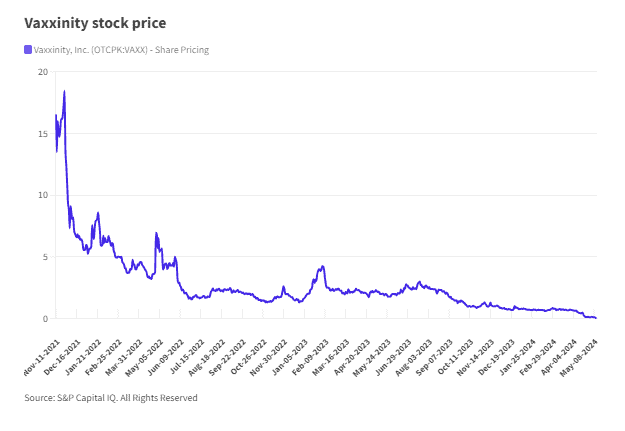Vaxxinity, which filed to delist from the Nasdaq last month, is choosing radical transparency about the “abusive relationship” that has defined the immunotherapy medicine company’s three-year stint as a public company.
“It’s not the last you’ll hear of us and we want people to know that it’s not like we’re just slinking away and giving up, so I think that was important,” CEO Mei Mei Hu said in an interview with Fierce Biotech.
The company, which listed in November 2021, marked the decision to back off of the market with a detailed letter to shareholders in April, signed by Hu and fellow company founder and Executive Chairman Lou Reese. The executives noted the many factors that drove them to the decision, including the overall decrease in the Biotech XBI, the withdrawal of institutional support from the market and the drying up of liquidity.
All these factors converged to push Vaxxinity into what Reese and Hu called “a downward spiral.”
Despite releasing clinical data over the time period that included positive phase 3 results, receiving a fast-track designation from the FDA for its Parkinson’s disease program, moving two programs into the clinic and receiving $10 million in non-dilutive funding, Vaxxinity’s shares still plummeted from the original list price of $16.11. Prior to announcing the delisting in April, the stock was worth 42 cents.
“Regardless of positive data, the markets would be selling into that because of a liquidity opportunity, right? And so those were new types of market dynamics. And when we saw that we said, ‘Look, in order to achieve our goal, which is to have this tremendous patient impact, we need to leave this abusive relationship, and we need to go and find relationships where we’re valued,’” Reese said.
That meant taking Vaxxinity private again.

An auspicious start
Vaxxinity went public in what many now look back on as the heyday of modern biotech—2021, the second year of the COVID-19 pandemic. The debut was just months after Vaxxinity became the company it is now, when COVID-focused COVAXX and brain immunotherapeutics company United Neuroscience fused together as subsidiaries.
The IPO raised $85 million at $13 per share, with the stock commencing trading on Nov. 11, 2021 under the ticker VAXX.
Hu and Reese never got to ring the bell at the Nasdaq but others on the Vaxxinity team did.
“We weren’t allowed in because we had COVID,” Reese said.
While the legacy neurological assets remained in play, Vaxxinity, like everyone else at that time, kicked into gear to develop a COVID-19 shot.
“When COVID came around, I think the whole world had to pivot. And it’s amazing what we can do when we rally together for a singular cause and so we came in on the bandwagon,” Hu said.
Vaxxinity tapped its Active Immunotherapy Medicine platform to develop a vaccine called UB-612. The shot went all the way to phase 3, going head-to-head with the now-approved option from Pfizer and BioNTech. But by the time UB-612 was ready to go, the world had moved on. Vaxxinity is not the only biotech to have a tale like this to tell after the pandemic years and there’s no regrets from Hu or Reese on pivoting to help the effort.
“What it showed us is that we can execute. We can bring something from literally an idea to phase 3 positive news in like a matter of a couple years. The problem for us is that COVID disappeared … it’s still around, but people got tired of it and it’s no longer a thing and so that market opportunity went away,” Hu said.
Vaxxinity went back to its original mission: Alzheimer’s and Parkinson’s. The company has UB-311 in phase 2 testing for the former and UB-312 in phase 1 for the latter. Another tau program called VXX-301 for Alzheimer’s is in the preclinical stage.
“We actually had so many learnings from our COVID sprint,” Hu said. “If COVID were still here, we’d be in a different spot. And the good news with diseases like Alzheimer’s and Parkinson’s is that the disease isn’t going away.”
Throughout this entire journey, the markets kept hammering Vaxxinity. The price plummeted below $1.
“We kept coming out with good news,” Hu reflected. “But then we began to notice that literally, when we had good news, the stock would go down. And it became a trend of selling into good news.”
Vaxxinity’s executives tried to compartmentalize the market activity and the clinical work, focusing on delivering, on the advice of investors. But it became harder to do. Reese said the share price still reflected a bad picture out to the world and that was hard to stomach. It affected the morale of staff and painted a negative picture for anyone looking to work with the company, whether they be a potential employee or external partner.
Reese said they watched as the Russell Index stayed down for three consecutive years, there was a 93% reduction in liquidity in terms of the money raised through IPOs. Vaxxinity was one of the last of 40 companies that went out in 2021 and only two were trading at or above their IPO price.
Neither Hu or Reese could pinpoint an exact moment when they made the decision to delist. “Most of the time there’s not like a eureka moment,” Hu said. But Reese cites two key pieces of data. One of their peer companies—which he did not name—released earnings and beat all analyst forecasts. The stock dropped 10% anyway.
“So that was the first one where I was like, this is actually fundamentally broken. It’s not even a revenue-based issue. It’s just broken,” Reese said.
Then Vaxxinity released data on the conference circuit that he called positive, and still the company faced downward pressure.
“Those two kinds of things really solidified the fact that it’s not functioning. It’s not a personal attack on me or Mei Mei or anybody that’s doing great work at Vaxxinity,” Reese said. “It’s just a market that fundamentally—based on the rules of the market for the last 35 years—is not functioning in that way.”
And so, Reese and Hu penned a letter, which began: “It is important to share why we made this decision to ‘go dark’ and why we believe it is in the best interests of the company and our shareholders over the longer term.”
Starting a lawnmower
Reese said transparency was important in this moment.
“I feel like we gave it our all and we’re gonna continue giving it our all, but we need people to know that we’re not quitting. We’re not giving up. We want to be transparent,” he said. “We understand why these things are a problem and why they’re tough for shareholders to swallow and all of that and we want them to have as much information as they can have.”
The executives also addressed the COVID shot and the decision to pivot right back to the neurodegenerative diseases that were originally the company’s mission.
“We recognize that COVID is no longer a top global health priority, but if it were, we believe we would have a best-in-class vaccine offered at 10% of our competitors’ price, or put another way, we would be fulfilling our mission to limit suffering and increase access to the best healthcare solutions in the world,” the letter read.
The letter also stated that Hu and Reese expect better access to capital on the private side. The pair declined to say what their plans are for fundraising going forward. In the company’s last earnings release in March, they reported $30.4 million in highly liquid assets, including $4.9 million of cash and cash equivalents and $25.5 million of short-term investments. This compared to $86.8 million as of Dec. 31, 2022.
Vaxxinity spent $3.7 million on directors and officers insurance to maintain the listing in the first year on the market alone, a necessary expenditure to have a Nasdaq listing, according to the letter.
Reese and Hu suspect there are many biotechs out there considering the same thing and that Vaxxinity’s move could be just the start of a trend of voluntary delistings.
“I hope that the companies make the best decisions that they can for their shareholders, whatever those are in their individual highly complicated circumstances,” Reese said.
They have been watching the handful of companies go out so far this year in the first quarter, followed by another quiet period. Hu said the looming U.S. election, stubborn inflation and other macro factors are contributing to companies’ hesitancy to list.
“Have you ever started a pull lawnmower? So I think about it like that. They were sitting there and that was the first pull after it’s been cold for a while. And they wanted to see if it would kick over. And the answer is it didn’t,” Reese said.
“I think they pulled that motor, and it started a little bit, and then just chugged out and there was some black smoke and you knew that the fuel was too rich and it was flooding.”

